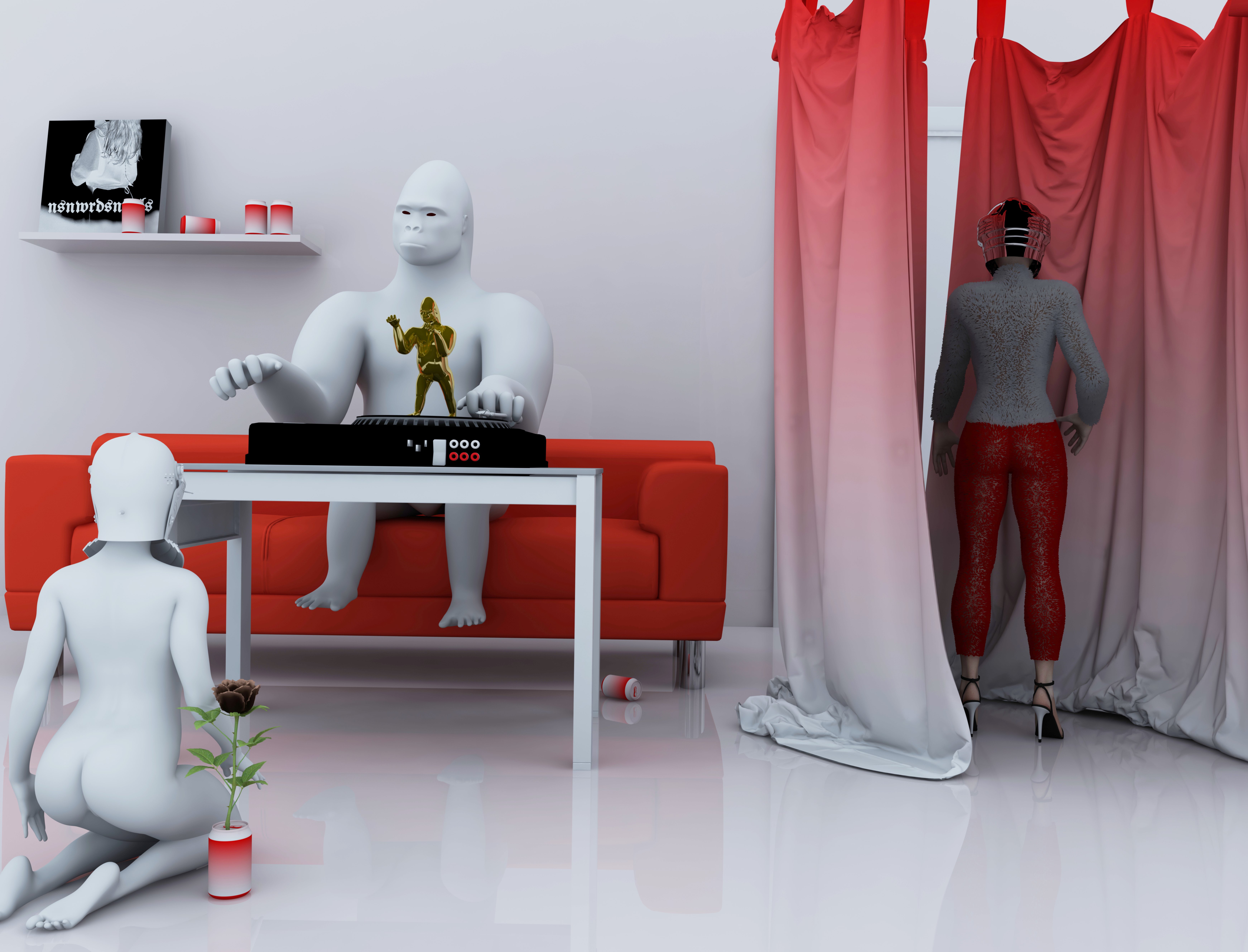The strange, seductive digital art of Olga Fedorova
- Text by Alice Bucknell
- Photography by Olga Fedorova

Both hypnotic and uncanny, seductive and foreboding – the digital artworks of Russian artist Olga Fedorova leave an immediate impression that’s hard to shake.
Rendered with 3D technology, her eerie scenes are charged with a symbolism that brings to mind the Belgian surrealists like René Magritte and Paul Delvaux. Her influences create a strange and wonderful aesthetic that resists an easy read.
Highly sexualized female bodies are always at the centre of the action, often nude save for helmets, knee-high boots, stilettos, or furry skintight suits. They perform elaborate exercises that dangle between idle play and ritual. The scenes could be cutting critiques of girl-on-girl surveillance and domestic entrapment, global capitalism and its anxious effects on the body – or just as a crop of surreal and funny avatars.
It’s easy to forget that – with her background in classical painting and a degree from the Ecole Nationale Supérieure des Arts Visuels de La Cambre (ENSAV) in Brussels – Olga still remains relatively new to the digital world. And as her she gets ready to open her first solo show in London this month, we caught up with her to find out more about her strangely seductive creations.

Always on my mind, 2017.

Rivals, 2017.
Who are the women in your work? What are they doing?
They are all women from my life, who I create through observing and analysing their behaviours. I place them in different environments and situations and let them interact. They are ambiguous and sometimes funny, sometimes friends and sometimes enemies. But they are always somehow erotic. They are stuck in a sort of technological and digital trance.
Tell me about your influences. I see tropical plants and animals mashed up with creepy modernist interiors.
I work intuitively and mix stories from my life with fictional stories. I was particularly inspired by an old Italian horror movie Suspiria (1977) which was inspired by Thomas De Quincey’s collection of psychological fantasy essays, Suspiria de Profundis (1858). The film blends supernatural and horrific with domestic settings. This tension interested me. I think that this is partially the reason why my women are often indoors.

Whitedog, 2017

In My House, 2017.
How does your background as a painter play into your new digital work?
It helps me a lot in thinking about the colour and composition of my digital paintings. But I am still exploring this new medium and experimenting with different approaches and perspectives.
Is feminism a part of your practice?
Feminism is a strong movement that has gained power in the digital revolution. My women are charged with a female energy, which I collect from observing the women in my everyday life situations. But the aesthetic side is always a secondary part for me.
How would you like outsiders to read your work?
There’s a quote from Jean-Paul Sartre: “A man is always a teller of stories. He sees everything that happens to him through them. And, he tries to live his life, as if he were telling a story.”

DJ set, 2017

Hot Work, 2017

Swimming Pool, 2017

Selfie, 2017
Generic Jungle is on show at Annka Kultys Gallery from November 16 – December 16 2017. It is the artist’s first solo show in London.
Enjoyed this article? Like Huck on Facebook or follow us on Twitter.
Latest on Huck

In the ’60s and ’70s, Greenwich Village was the musical heart of New York
Talkin’ Greenwich Village — Author David Browne’s new book takes readers into the neighbourhood’s creative heyday, where a generation of artists and poets including Bob Dylan, Billie Holliday and Dave Van Ronk cut their teeth.
Written by: Cyna Mirzai

How Labour Activism changed the landscape of post-war USA
American Job — A new exhibition revisits over 70 years of working class solidarity and struggle, its radical legacy, and the central role of photography throughout.
Written by: Miss Rosen

Analogue Appreciation: Emma-Jean Thackray
Weirdo — In an ever more digital, online world, we ask our favourite artists about their most cherished pieces of physical culture. Today, multi-instrumentalist and Brownswood affiliate Emma-Jean Thackray.
Written by: Emma-Jean Thackray

Meet the shop cats of Hong Kong’s Sheung Wan district
Feline good — Traditionally adopted to keep away rats from expensive produce, the feline guardians have become part of the central neighbourhood’s fabric. Erica’s online series captures the local celebrities.
Written by: Isaac Muk

How trans rights activism and sex workers’ solidarity emerged in the ’70s and ’80s
Shoulder to Shoulder — In this extract from writer Jake Hall’s new book, which deep dives into the history of queer activism and coalition, they explore how anti-TERF and anti-SWERF campaigning developed from the same cloth.
Written by: Jake Hall

A behind the scenes look at the atomic wedgie community
Stretched out — Benjamin Fredrickson’s new project and photobook ‘Wedgies’ queers a time-old bullying act by exploring its erotic, extreme potential.
Written by: Isaac Muk